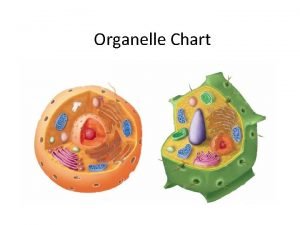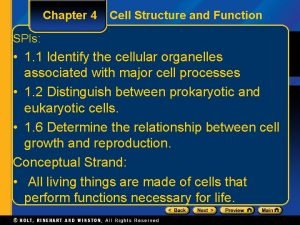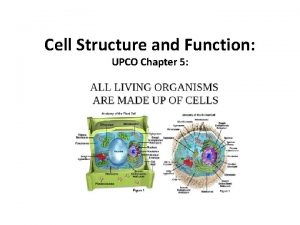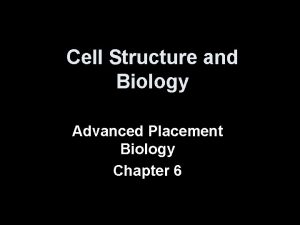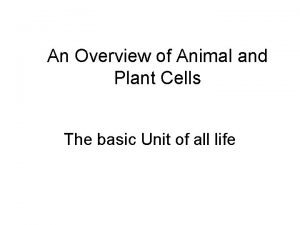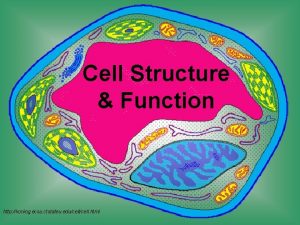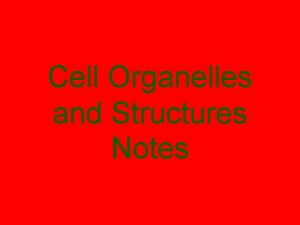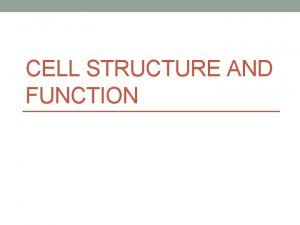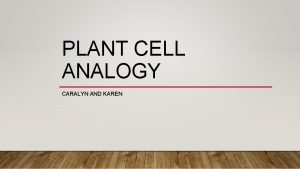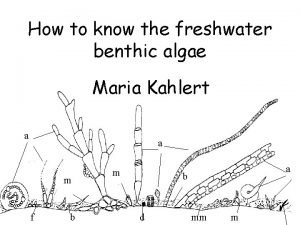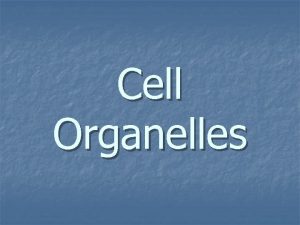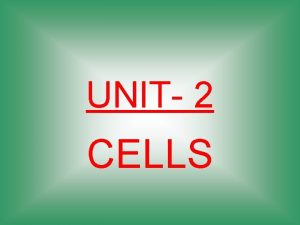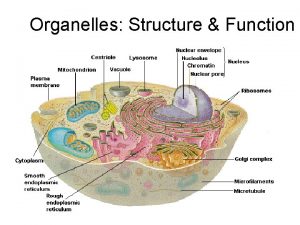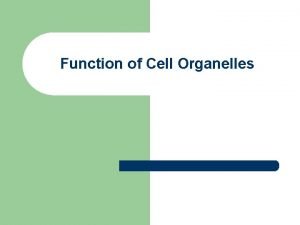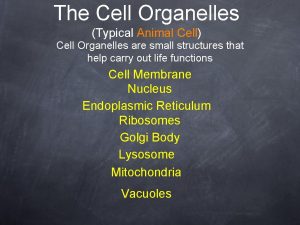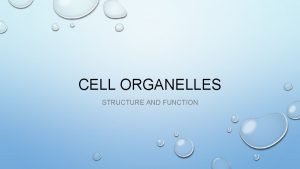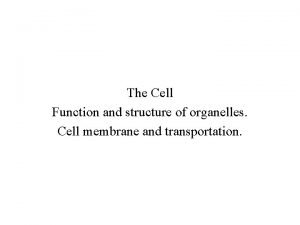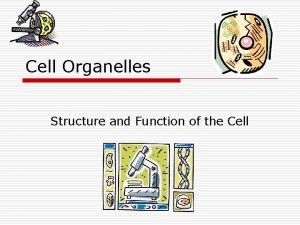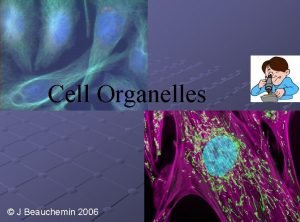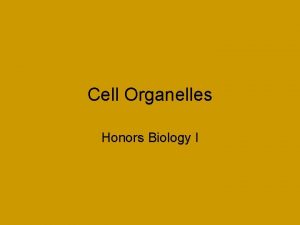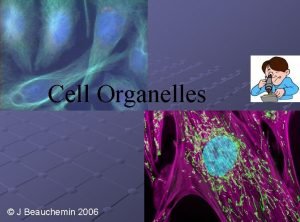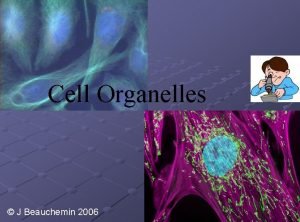Chapter 4 Cell structure and Function Cell Organelles


















- Slides: 18

Chapter 4: Cell structure and Function Cell Organelles and Features

What structures do we have in a cell?

Student objectives: 1. Describe the structure and function of a cell’s plasma membrane. 2. Summarize the role of the nucleus. 3. List major organelles found in the cytosol, and describe their roles. 4. Identify the characteristics of mitochondria. 5. Describe the structure and function of the cytoskeleton.

Plasma Membrane The plasma membrane (cell membrane) allows only certain molecules to enter or leave the cell. It separates internal metabolic reactions from the external environment. It allows the cell to excrete wastes and to interact with its environment.

Membrane Lipids The plasma membrane is primarily made of phospholipids. Phospholipids have polar hydrophilic phosphate head and two nonpolar hydrophobic fatty acid tails. They line up in a phospholipid bilayer. Cell membranes also contain sterols (other lipids such as cholesterol).

Membrane Proteins Plasma membranes also contains integral proteins in the lipid bilayer. Receptor proteins Transport proteins

Fluid mosaic model A cell’s membrane is very dynamic. The fluid mosaic model states that the phospholipid bilayer behaves more life a fluid than a solid. Membrane lipids and proteins can move laterally within the bilayer.

Nucleus The nucleus is filled with a jellylike liquid called the nucleoplasm, which holds contents of the nucleus and is similar to the cytoplasm. The nucleus houses and protects the cell’s genetic information (DNA). When a cell is not dividing it is in a threadlike form called chromatin. When a cell is about to divide, the chromatins condenses to form chromosomes. The nucleus is where DNA is transcribed into ribonucleic acid (RNA).

Nuclear Envelope The nucleus is surrounded by a double membrane called the nuclear envelope. It is made of two phospholipid bilayers. RNA can enter and leave the nuclear envelope via nuclear pores.

Nucleolus Most nuclei contain at least one denser area, called the nucleolus. The nucleolus is the site where DNA is concentrated when it is making ribosomal RNA. Ribosomes are organelles made of protein and RNA that direct protein synthesis in the cytoplasm.

Mitochondria are tiny organelles that transfer energy from organic molecules to adenosine triphosphate (ATP). ATP powers the cell’s chemical reactions. A mitochondrion has an inner and outer phospholipid membrane. Mitochondria have their own DNA and reproduce only by division of preexisting mitochondria. Scientists think that mitochondria originated from prokaryotic cells that were incorporated into ancient eukaryotic cells.

Ribosomes are small, toughly spherical organelles that are responsible for building protein. Ribosomes do not have a membrane. They are made of protein and RNA molecules.

Endoplasmic reticulum The endoplasmic reticulum (ER) is a system of membranous tubes and sacs. The ER functions primarily as a intracellular highway. There are two types of ER: Rough ER: covered with ribosomes and produces phospholipids and proteins. Smooth ER: lacks ribosomes and produces lipids.

Golgi Apparatus The Golgi apparatus is a system of flattened, membranous sacs. The sacs receive newly made proteins and lipids and transport the substances.

Vesicles have a single membrane and transport and/or digest wastes within the cell. Lysosomes are vesicles that contain digestive enzymes (for large molecules, bacteria, and cells).

Cytoskeleton The cytoskeleton is a network of thin tubules and filaments that crisscrosses the cytosol. They give shape and act as internal tracks. 1. Microtubules: hollow tubes made of a protein called tubulin. 2. Microfilaments: long threads of protein actin for cell movement of white blood cells and for muscle contraction. 3. Intermediate filaments: rods that anchor the nucleus and some other organelles to their place.

Cilia and Flagella are hair like structures that extend from the surface of the cell, where they assist in movement.

Review questions 1. What’s DNA? 2. What is the function of the nucleus? 3. Identify two characteristics that make mitochondria different from other organelles. 4. List three types of cytoskeletons.
 During interphase, a cell grows, duplicates organelles, and
During interphase, a cell grows, duplicates organelles, and Facts about the vacuole
Facts about the vacuole Section 4-3 cell organelles and features
Section 4-3 cell organelles and features Organelles graphic organizer
Organelles graphic organizer Parts of a cell graphic organizer
Parts of a cell graphic organizer Biology chapter 7 cell structure and function
Biology chapter 7 cell structure and function Chapter 7 cell structure and function section review 7-2
Chapter 7 cell structure and function section review 7-2 Chapter 5 cell structure and function
Chapter 5 cell structure and function Label the organelles in the composite cell
Label the organelles in the composite cell Label the organelles in the composite cell
Label the organelles in the composite cell Cell organelles song
Cell organelles song White blood cell organelles
White blood cell organelles Cytoplasm nickname
Cytoplasm nickname Organelle of walls and studs
Organelle of walls and studs Plant cell organelles
Plant cell organelles Cytoplasm analogy house
Cytoplasm analogy house Cell organelles
Cell organelles What is this cell
What is this cell Cell organelles song
Cell organelles song

